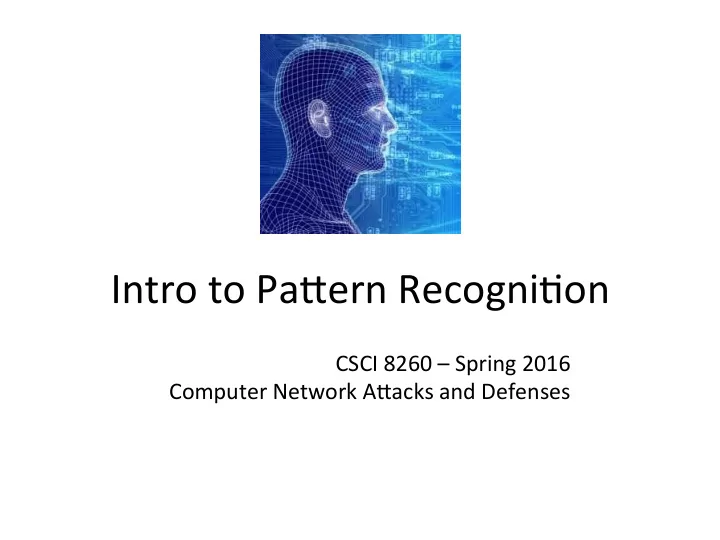

Intro to Pa)ern Recogni/on CSCI 8260 – Spring 2016 Computer Network A)acks and Defenses
What’s Pa)ern Recogni/on? • Target problem: build a system that automa/cally recognizes and categorizes objects into classes – Measure a number of features that characterize the object (e.g., color, size, shape, weight, etc.) – Input these measurement into the system – Obtain the correct class label Apples Pa)ern Recogni/on System Pears
Types of Features Example features for apples Quan/ta/ve • Weight (con/nuous) • Darkness level, 1-255 (discrete) • Qualita/ve • Color {red,yellow,green} (nominal) • Sweetness level {sour,sweet,very-sweet,extremely-sweet} (ordinal) •
Real-World Applica/on Example
Bayesian Decision Theory Nota/on • – X = [length, lightness] – W1 = salmon – W2 = see bass Assume we know the following • – P(X|W1) = P(length,lightness|salmon) – P(X|W2) = P(length,lightness|see bass) Bayes Rule • – P(W1|X) = P(X|W1)P(W1)/P(X) – P(W2|X) = P(X|W2)P(W2)/P(X) Op/mum Decision rule for a new input X’ • – Decide W1 if P(W1|X’) > P(W2|X’), otherwise decide W2 – In other words: P(X’|W1)/P(X’|W2) > P(W2)/P(W1) : then W1, else W2 In reality, we do not know the true P(X|W1) and P(X|W2)!
Approximate Class-condi/onal distribu/ons • ~P(length|W i ) – E.g., es/mated from examples of labeled fish provided by a fisherman
Approximate Class-condi/onal distribu/ons • ~P(lightness|W i ) – Es/mated from examples
Learning a Decision Surface • Linear classifier
“Flexible” Classifier • Very “flexible” classifier (e.g., Ar/ficial Neural Nets)
Learning a Decision Surface • Quadra/c Classifier
Decision Surface • Different classifier learn different models – Different generaliza/on ability – Different accuracy when tes/ng on a separate dataset
Supervised Learning in prac/ce • Assume you have a large dataset of labeled examples – Each entry represents an objects (its features) – Each object is assigned a “ground-truth” label” • e.g., labeled fruits, labeled • Split the dataset in two parts – Use a training set to automa/cally learn an object model – Use a test set to evaluate how your model is going to perform on never- before-seen data
Another example
Learned Decision Tree
Evalua/on Metrics • Test results help es/mate accuracy
False Posi/ves vs. True Posi/ves • Let N be the total number of test instances (or pa)erns) in the test dataset • Instances can belong to two possible classes – Posi/ve (or target) class – Nega/ve class • TP = Number of correctly classified posi/ve sampels • FP = Num of misclassified nega/ve samples
ROC and AUC • ROC = Receiver Opera/ng Characteris/c Curve – Plots trade-off between FPs and TPs for varying detec/on thresholds • AUC = Area under the ROC (the larger the be)er)
Unsupervised Learning • Learn from unlabeled examples – Seriously??? – Yes! • Discover groups of similar objects in a mul/- dimensional feature space – Provides new useful informa/on – Discovers new “concepts” or previously unknown classes
Clustering • Different clustering algorithms find different data clusters
Hierarchical Clustering
Pa)ern Recogni/on Process
Security Applica/ons • Network/Host-based Intrusion Detec/on • Malware Detec/on • Detec/ng Search Poisoning • Detec/ng Malicious Domain Names • Etc.
Example Security Applica/on • Given a PE file (e.g., an MS-Windows .exe file) – Decide if the file is “packed” without running it [1] [1] Roberto Perdisci, Andrea Lanzi, Wenke Lee. "Classifica/on of Packed Executables for Accurate Computer Virus Detec/on." Pa)ern Recogni/on Le)ers, 29(14), 2008, pp. 1941-1946.
Recommend
More recommend